GATE 2021 CS-Set-2
Question 1 |
Listening to music has no effect on learning and a positive effect on physical exercise. | |
Listening to music has a clear positive effect on physical exercise. Music has a positive effect on learning only in some students. | |
Listening to music has a clear positive effect both on physical exercise and on learning. | |
Listening to music has a clear positive effect on learning in all students. Music has a positive effect only in some students who exercise. |
From the first statement “Listening to music during exercise improves exercise performance and reduces discomfort. “ It is clear that listening to music has a positive effect on physical exercise.
From the statement “Scientists researched whether listening to music while studying can help students learn better and the results were inconclusive. “ it is clear that only on some students music has a positive effect.
Question 2 |

A transparent square sheet shown above is folded along the dotted line. The folded sheet will look like _______.
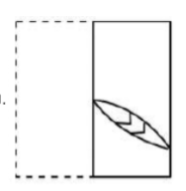 | |
 | |
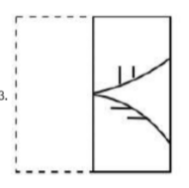 | |
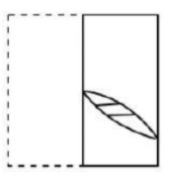 |
Question 3 |
as worse as | |
as well as | |
as better as | |
as nicest as |
Question 4 |
Vegetables | |
Sharp | |
Blunt | |
Cut |
Question 5 |
66 | |
22 | |
88 | |
110 |
Given Initial ratio : 3:13:6
Total number of students initially = 3x+13x+6x = 22x
From the given question, we can write 3x+18 = 15y -----I
13x+18 = 35y-----II
6x+18 = 21y------III
I - II => -10X = -20Y
X=2Y------IV
Put IV in III => 6(2y) + 18 = 21y
12y + 18 = 21y
9y = 18
y = 2 -----V
Substitute V in I => 3x + 18 = 30
3x = 12
x = 4
Number of initial students = 22x = 22(4) = 88
Question 6 |
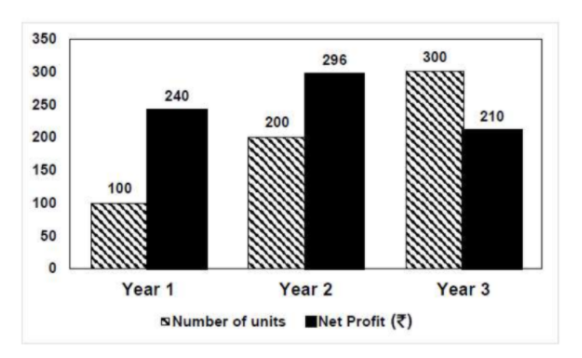
The number of units of a product sold in three different years and the respective net profits are presented in the figure above. The cost/unit in Year 3 was ₹ 1, which was half the cost/unit in Year 2. The cost/unit in Year 3 was one-third of the cost/unit in Year 1. Taxes were paid on the selling price at 10%, 13% and 15% respectively for the three years. Net profit is calculated as the difference between the selling price and the sum of cost and taxes paid in that year.
The ratio of the selling price in Year 2 to the selling price in Year 3 is ______.
1:1 | |
3:4 | |
1:2 | |
4:3 |
According to the given data:
Year Cost/unit Number of units Cost Price
1 ₹ 3 100 300
2 ₹ 2 200 400
3 ₹ 1 300 300
Cost Price = Cost/unit x Number of units
Net Profit = Selling Price - (Cost Price + (Tax% x selling price )
Year 2:
296 = SP - (400 + (13/100) x SP)
=>296 = 0.87SP - 400
=> 0.87SP = 696
=> SP = ₹ 800
Year 3:
210 = SP - (300 + (15/100) x SP)
=> 210 = 0.85SP - 300
=> 0.85SP = 510
=> SP = ₹ 600
The ratio of selling price in Year 2 to the selling price in year 3 = 800:600
= 4:3
Question 7 |
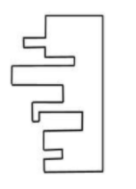
A jigsaw puzzle has 2 pieces. One of the pieces is shown above. Which one of the given options for the missing piece when assembled will form a rectangle? The piece can be moved, rotated or flipped to assemble with the above piece.
 | |
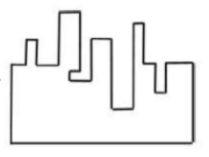 | |
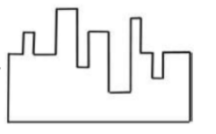 | |
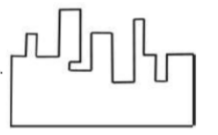 |
Question 8 |
2 | |
4 | |
8 | |
6 |
Expand the given equation:
x2+1/4 - x -x2 -9/4 +3x = x+2
=> -2 + 2x = x + 2
X = 4
Question 9 |
 | |
 | |
 | |
 |
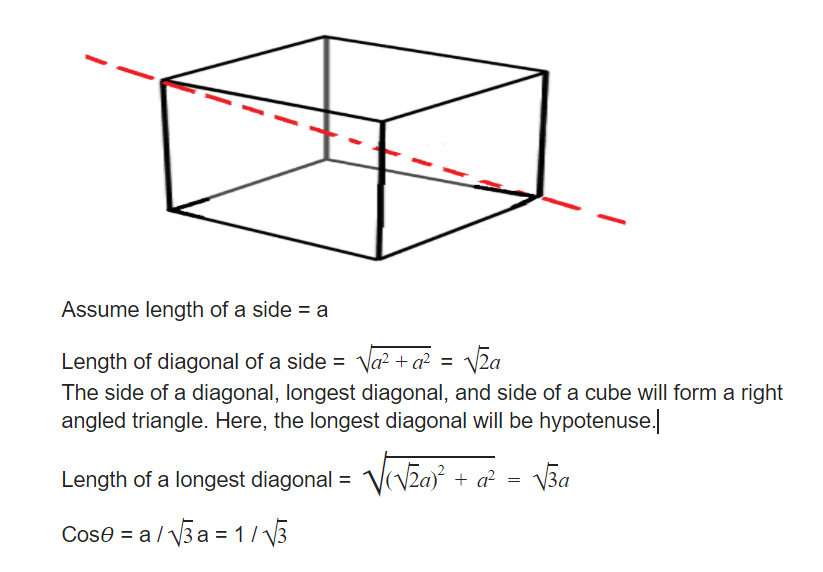
Question 10 |
Observation I: S is taller than R.
Observation II: Q is the shortest of all.
Observation III: U is taller than only one student.
Observation IV: T is taller than S but is not the tallest.
The number of students that are taller than R is the same as the number of students shorter than _______.
S | |
P | |
T | |
R |
Number of students taller than R = Number of students shorter than S = 3
Question 11 |
SYN bit = 1, SEQ number = X+1, ACK bit = 0, ACK number = Y, FIN bit = 0 | |
SYN bit = 0, SEQ number = X+1, ACK bit = 0, ACK number = Y, FIN bit = 1 | |
SYN bit = 1, SEQ number = Y, ACK bit = 1, ACK number = X+1, FIN bit = 0 | |
SYN bit = 1, SEQ number = Y, ACK bit = 1, ACK number = X, FIN bit = 0 |
Q will send the SYN bit = 1 to the connection establishment.
Q Seq number will be Y different from X
ACK bit = 1 because sending the ACK
ACK number = X+1 (Next seq number id)
FIN bit = 0 (Because establishing the connection)
Question 12 |
(0+1 (01*0)*1)* | |
(0+11+10(1+00)*01)* | |
(0*(1(01*0)*1)*)* | |
(0+11+11(1+00)*00)* |
Transition table
|
0 |
1 |
|
|
->*q0 |
q0 |
q1 |
|
q1 |
q2 |
q0 |
|
q2 |
q1 |
q2 |
DFA of divisible by 3

The regular expression will be
Three paths to reach to final state from initial state
Path 1: self loop of 0 on q0
Path 2: q0->q1->q0 hence 11
Path 3: q0->q1->q2->q1->q0 hence 10(1+00)*01
So finally the regular expression will be
(0+11+10(1+00)*01)*
Other regular expression is (if we consider two paths)
Path 1: Path 1: self loop of 0 on q0
Path 2: q0->q1->q2*->q1->q0
Hence regular expression
(0+1 (01*0)*1)*
Another regular expression is (if we consider only one path and remaining part is present inside this path as cycles)
q0->q1->q2->q1->q0
Another regular expression is
(0*(1(01*0)*1)*)*
So A,B, C are correct.
Option D generates string 11100 which is not accepted by FA hence wrong.
Question 13 |
L={w x wR xR | w, x ∈ {0,1}* } | |
L={w wR x xR | w, x ∈ {0,1}* } | |
L={w x xR wR | w, x ∈ {0,1}* } | |
L={w x wR | w, x ∈ {0,1}* } |
Option A: L={w x wR xR | w, x ∈ {0,1}* }
This is not CFL as if we push “w” then “x” then we cannot match wR with “w” as top of stack contains x.
Option B: L={w wR x xR | w, x ∈ {0,1}* }
This is CFL. We non deterministically guess the middle of the string. So we push “w” then match with wR and again push x and match with xR
Option C: L={w x xR wR | w, x ∈ {0,1}* }
This is also CFL. We non deterministically guess the middle of the string. So we push “w” then push x and then match with xR and again match with wR
Option D: L={w x wR | w, x ∈ {0,1}* }
This is a regular language (hence CFL). In this language every string start and end with same symbol (as x can expand).
Question 14 |
USE(S) : the set of variables used in S
IN(S) : the set of variables that are live at the entry of S
OUT(S) : the set of variables that are live at the exit of S
Consider a basic block that consists of two statements, S1followed by S2. Which one of the following statements is correct?
OUT(S1) =IN(S2) U OUT(S2) | |
OUT(S1) =IN(S1) U USE(S1) | |
OUT(S1) =USE(S1) U IN(S2) | |
OUT(S1) =IN(S2) |
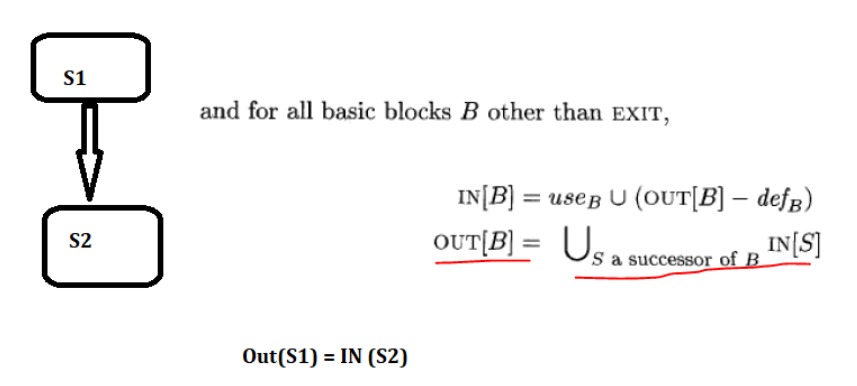
Question 15 |
698 |
Total no. of records = 150000
Block size = 4096 bytes
Key size = 12 bytes
Record pointer size = 7 bytes

Question 16 |
#include <stdio.h>
int foo(intx, int y, int q)
{
if ((x <= 0) && (y <= 0))
return q;
if (x <= 0)
return foo(x, y-q, q);
if (y <= 0)
return foo(x-q, y, q);
return foo(x, y-q, q) + foo(x-q, y, q);
}
int main()
{
int r = foo(15, 15, 10);
printf(“%d”, r);
return 0;
}
The output of the program upon execution is ______
60 |
int foo(intx, int y, int q)
{
if ((x <= 0) && (y <= 0)) //if 1
return q;
if (x <= 0) //if 2
return foo(x, y-q, q);
if (y <= 0) //if 3
return foo(x-q, y, q);
return foo(x, y-q, q) + foo(x-q, y, q);
}
int main()
{
int r = foo(15, 15, 10);
printf(“%d”, r);
return 0;
}
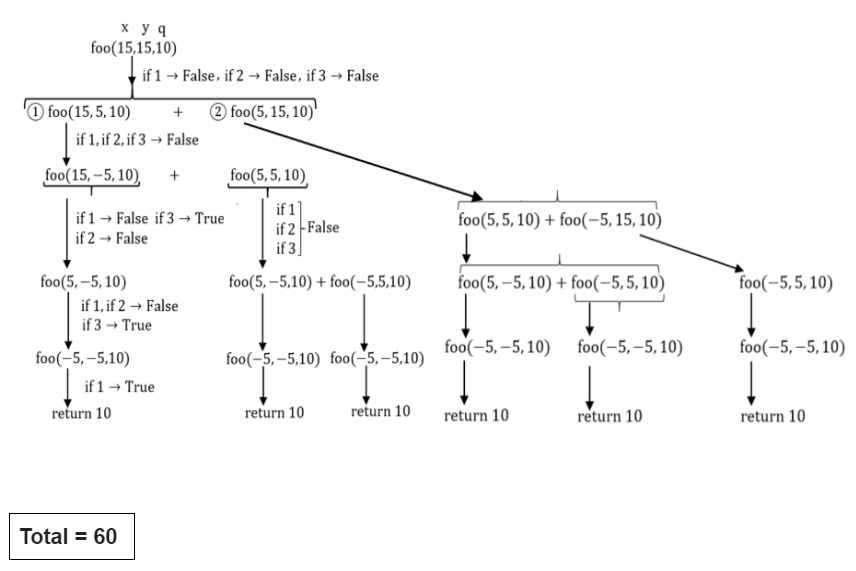
GATE 2021 CS-Set-2
Question 1 |
Listening to music has no effect on learning and a positive effect on physical exercise. | |
Listening to music has a clear positive effect on physical exercise. Music has a positive effect on learning only in some students. | |
Listening to music has a clear positive effect both on physical exercise and on learning. | |
Listening to music has a clear positive effect on learning in all students. Music has a positive effect only in some students who exercise. |
From the first statement “Listening to music during exercise improves exercise performance and reduces discomfort. “ It is clear that listening to music has a positive effect on physical exercise.
From the statement “Scientists researched whether listening to music while studying can help students learn better and the results were inconclusive. “ it is clear that only on some students music has a positive effect.
Question 2 |

A transparent square sheet shown above is folded along the dotted line. The folded sheet will look like _______.
 | |
 | |
 | |
 |
Question 3 |
as worse as | |
as well as | |
as better as | |
as nicest as |
Question 4 |
Vegetables | |
Sharp | |
Blunt | |
Cut |
Question 5 |
66 | |
22 | |
88 | |
110 |
Given Initial ratio : 3:13:6
Total number of students initially = 3x+13x+6x = 22x
From the given question, we can write 3x+18 = 15y -----I
13x+18 = 35y-----II
6x+18 = 21y------III
I - II => -10X = -20Y
X=2Y------IV
Put IV in III => 6(2y) + 18 = 21y
12y + 18 = 21y
9y = 18
y = 2 -----V
Substitute V in I => 3x + 18 = 30
3x = 12
x = 4
Number of initial students = 22x = 22(4) = 88
Question 6 |

The number of units of a product sold in three different years and the respective net profits are presented in the figure above. The cost/unit in Year 3 was ₹ 1, which was half the cost/unit in Year 2. The cost/unit in Year 3 was one-third of the cost/unit in Year 1. Taxes were paid on the selling price at 10%, 13% and 15% respectively for the three years. Net profit is calculated as the difference between the selling price and the sum of cost and taxes paid in that year.
The ratio of the selling price in Year 2 to the selling price in Year 3 is ______.
1:1 | |
3:4 | |
1:2 | |
4:3 |
According to the given data:
Year Cost/unit Number of units Cost Price
1 ₹ 3 100 300
2 ₹ 2 200 400
3 ₹ 1 300 300
Cost Price = Cost/unit x Number of units
Net Profit = Selling Price - (Cost Price + (Tax% x selling price )
Year 2:
296 = SP - (400 + (13/100) x SP)
=>296 = 0.87SP - 400
=> 0.87SP = 696
=> SP = ₹ 800
Year 3:
210 = SP - (300 + (15/100) x SP)
=> 210 = 0.85SP - 300
=> 0.85SP = 510
=> SP = ₹ 600
The ratio of selling price in Year 2 to the selling price in year 3 = 800:600
= 4:3
Question 7 |

A jigsaw puzzle has 2 pieces. One of the pieces is shown above. Which one of the given options for the missing piece when assembled will form a rectangle? The piece can be moved, rotated or flipped to assemble with the above piece.
 | |
 | |
 | |
 |
Question 8 |
2 | |
4 | |
8 | |
6 |
Expand the given equation:
x2+1/4 - x -x2 -9/4 +3x = x+2
=> -2 + 2x = x + 2
X = 4
Question 9 |
 | |
 | |
 | |
 |

Question 10 |
Observation I: S is taller than R.
Observation II: Q is the shortest of all.
Observation III: U is taller than only one student.
Observation IV: T is taller than S but is not the tallest.
The number of students that are taller than R is the same as the number of students shorter than _______.
S | |
P | |
T | |
R |
Number of students taller than R = Number of students shorter than S = 3
Question 11 |
SYN bit = 1, SEQ number = X+1, ACK bit = 0, ACK number = Y, FIN bit = 0 | |
SYN bit = 0, SEQ number = X+1, ACK bit = 0, ACK number = Y, FIN bit = 1 | |
SYN bit = 1, SEQ number = Y, ACK bit = 1, ACK number = X+1, FIN bit = 0 | |
SYN bit = 1, SEQ number = Y, ACK bit = 1, ACK number = X, FIN bit = 0 |
Q will send the SYN bit = 1 to the connection establishment.
Q Seq number will be Y different from X
ACK bit = 1 because sending the ACK
ACK number = X+1 (Next seq number id)
FIN bit = 0 (Because establishing the connection)
Question 12 |
(0+1 (01*0)*1)* | |
(0+11+10(1+00)*01)* | |
(0*(1(01*0)*1)*)* | |
(0+11+11(1+00)*00)* |
Transition table
|
0 |
1 |
|
|
->*q0 |
q0 |
q1 |
|
q1 |
q2 |
q0 |
|
q2 |
q1 |
q2 |
DFA of divisible by 3

The regular expression will be
Three paths to reach to final state from initial state
Path 1: self loop of 0 on q0
Path 2: q0->q1->q0 hence 11
Path 3: q0->q1->q2->q1->q0 hence 10(1+00)*01
So finally the regular expression will be
(0+11+10(1+00)*01)*
Other regular expression is (if we consider two paths)
Path 1: Path 1: self loop of 0 on q0
Path 2: q0->q1->q2*->q1->q0
Hence regular expression
(0+1 (01*0)*1)*
Another regular expression is (if we consider only one path and remaining part is present inside this path as cycles)
q0->q1->q2->q1->q0
Another regular expression is
(0*(1(01*0)*1)*)*
So A,B, C are correct.
Option D generates string 11100 which is not accepted by FA hence wrong.
Question 13 |
L={w x wR xR | w, x ∈ {0,1}* } | |
L={w wR x xR | w, x ∈ {0,1}* } | |
L={w x xR wR | w, x ∈ {0,1}* } | |
L={w x wR | w, x ∈ {0,1}* } |
Option A: L={w x wR xR | w, x ∈ {0,1}* }
This is not CFL as if we push “w” then “x” then we cannot match wR with “w” as top of stack contains x.
Option B: L={w wR x xR | w, x ∈ {0,1}* }
This is CFL. We non deterministically guess the middle of the string. So we push “w” then match with wR and again push x and match with xR
Option C: L={w x xR wR | w, x ∈ {0,1}* }
This is also CFL. We non deterministically guess the middle of the string. So we push “w” then push x and then match with xR and again match with wR
Option D: L={w x wR | w, x ∈ {0,1}* }
This is a regular language (hence CFL). In this language every string start and end with same symbol (as x can expand).
Question 14 |
USE(S) : the set of variables used in S
IN(S) : the set of variables that are live at the entry of S
OUT(S) : the set of variables that are live at the exit of S
Consider a basic block that consists of two statements, S1followed by S2. Which one of the following statements is correct?
OUT(S1) =IN(S2) U OUT(S2) | |
OUT(S1) =IN(S1) U USE(S1) | |
OUT(S1) =USE(S1) U IN(S2) | |
OUT(S1) =IN(S2) |

Question 15 |
698 |
Total no. of records = 150000
Block size = 4096 bytes
Key size = 12 bytes
Record pointer size = 7 bytes

Question 16 |
#include <stdio.h>
int foo(intx, int y, int q)
{
if ((x <= 0) && (y <= 0))
return q;
if (x <= 0)
return foo(x, y-q, q);
if (y <= 0)
return foo(x-q, y, q);
return foo(x, y-q, q) + foo(x-q, y, q);
}
int main()
{
int r = foo(15, 15, 10);
printf(“%d”, r);
return 0;
}
The output of the program upon execution is ______
60 |
int foo(intx, int y, int q)
{
if ((x <= 0) && (y <= 0)) //if 1
return q;
if (x <= 0) //if 2
return foo(x, y-q, q);
if (y <= 0) //if 3
return foo(x-q, y, q);
return foo(x, y-q, q) + foo(x-q, y, q);
}
int main()
{
int r = foo(15, 15, 10);
printf(“%d”, r);
return 0;
}

